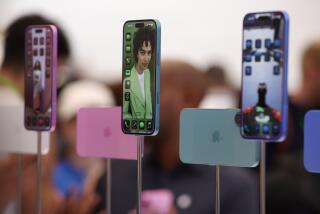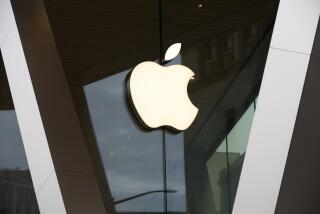2 New Programs Could Help Apple Stay Ahead of IBM : Software Expected to Spur Sales of Popular Macintosh
- Share via
CUPERTINO, Calif. — Apple Computer today will unveil a pair of new programs for the Macintosh personal computer that will considerably broaden the machine’s capabilities and, according to analysts, help Apple maintain its 12- to 18-month technological lead over IBM.
The first piece of software, known as HyperCard, is essentially a database program that allows Macintosh owners to use and create files that combine information in the form of text, graphics, video, voice, music and animation.
Besides spurring the already hot sales of the Macintosh, which powered Apple to a 42% gain in revenue in its last quarter, analysts predicted that HyperCard, available to the public this month, would speed the commercialization of new technologies for information storage and retrieval. One such technology that can be used with HyperCard, CD-ROM, employs compact disks that contain hundreds of times more data than the conventional floppy disks used by personal computers.
“Apple has just pushed CD-ROM development ahead by several years,” said Jan Lewis, head of Palo Alto Research Group.
Browse Through a Gallery
The Point Foundation in Sausalito plans to create an audio-visual version of its Whole Earth Catalog on compact disk for use with HyperCard. The entry on “bird watching,” for example, will include book reviews, pictures and recorded bird calls.
“Apple is not exaggerating the importance of this product by one iota,” Lewis said. “This is a breakthrough product that will create an entire new class of software.”
With HyperCard, a user browsing through a videodisk cataloguing 1,500 artworks from the National Gallery of Art in Washington could call up images on a television screen or monitor of all paintings by Rembrandt, or all impressionist landscapes, or all still-lifes that depict flowers.
“It will be as easy as browsing through a book or wandering through a museum,” said Aleen Stein, a partner in Los Angeles-based Voyager Co., which is releasing a HyperCard version of the guide to the National Gallery.
The new technology, analysts said, should keep Apple comfortably ahead of IBM.
“At a time when IBM is moving into Apple’s realm by integrating text and graphics, Apple is jumping ahead by integrating all these other kinds of data,” said David Carnevale, an analyst for InfoCorp, a Cupertino market research firm.
“This is probably the most significant new PC software since the Mac itself made its debut,” added Peter Teige, an analyst with Dataquest, a San Jose market research firm.
HyperCard allows users to navigate through data much as the human mind would--by association--in contrast with existing database software, which hews closely to designated guidelines. The software also will allow novices to become programmers, Apple said in a briefing with reporters.
“Finally, we have a program that allows the personal computer to act as a personal agent, even as an extension of our own will,” said Bill Atkinson, the Apple scientist who wrote the HyperCard.
The second new program, called MultiFinder, is a new operating system that lets the Macintosh perform up to 30 applications simultaneously. For example, with MultiFinder, a computer user will be able to do financial calculations while writing a letter--without having to go through the cumbersome procedure of exiting one program and entering another.
“It allows people to do things when they want to do them, rather than waiting until another job gets finished,” said Stewart Alsop, publisher of the PC Letter in Redwood City.
Macintoshes equipped with special circuit boards will even be able to run software designed for IBM personal computers simultaneously with software specifically made for Apple equipment. This would be the first operating system allowing simultaneous use of software written for the rival computers.
Like HyperCard, the new operating system will give Apple a jump on IBM. The computer industry giant has promised what is known as multitasking capability for the Operating System/2 that it plans to deliver next year.
“It looks like Apple has a good shot at proving wrong the conventional wisdom that IBM always wins,” Alsop said, suggesting that the Armonk, N.Y., computer giant may be too busy battling Compaq and other makers of IBM-compatible equipment to bother with Apple.
HyperCard and MultiFinder, to be introduced this week at the MacWorld Exhibition trade show in Boston, come at a time when the market for Macintosh equipment is exploding. Both programs will be packaged with new Macintosh computers at no extra charge and sold to existing Macintosh owners for a nominal fee.
Last month, Apple reported a 65% gain in net income on a 42% increase in sales for its third fiscal quarter, and Chairman and Chief Executive John Sculley recently predicted another 40% gain in sales during the fourth fiscal quarter.
Sculley, at an analysts meeting last month, also said the PC industry as a whole would grow by 25% next year and that Apple’s “intent” is to “gain market share.”
Sculley noted that the Macintosh has gained a foothold in corporate America because of its utility for desktop publishing, and predicted that the next major growth area will be in desktop presentations--the use of personal computers to make slides, overhead transparencies and flipcharts.
To take advantage of burgeoning demand, Sculley said, Apple is boosting its field sales force by 25% this quarter.






